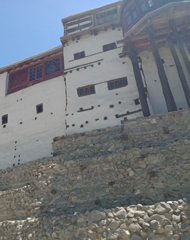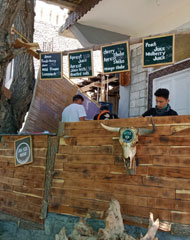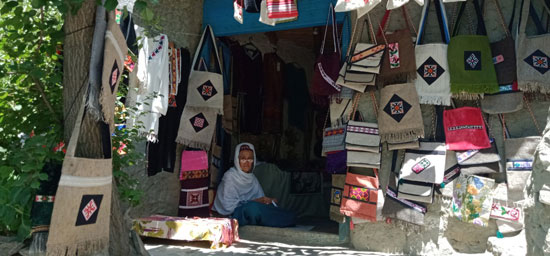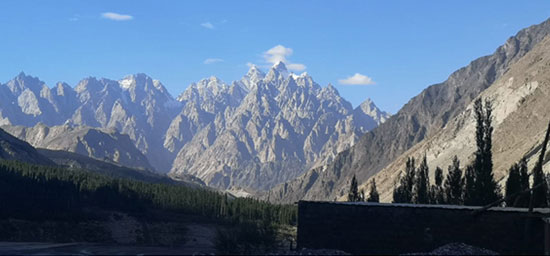About the Author:
Durriyah Balkhi Asghar, CPA, is an alumna of Class of ’91. She is a Tax and Financial Consultant, as well as an educator. She began her career with PriceWaterhouse, New York and is currently on a sabbatical.
Our Most Memorable Moments in Hunza - July 2021

#1: Fresh apricot juice with nuts and wildflower lemonade from Juice Box, under the shade of a tree that had a wooden balcony in it like a treehouse. This was in the street leading down from Baltit Fort, around the corner from a residence that was small like a dollhouse, with vines of pink and purple morning glory flowers going up from its balcony to its roof. Quaint shops sold colorful, hand embroidered bags, shawls, wall-hangings, rugs, dry fruits, locally produced jams and varieties of honey. We bought lots of jars of mulberry, apricot, fig and cherry jam as presents for family and friends. It was a most picturesque place to be.
Karimabad, previously called Baltit, is markedly different from the rest of Pakistan with its cleanliness and the courteous behavior of the locals. Women can be seen in shalwar qameez and are often heading small business ventures. The men are almost always in western attire. Literacy is said to be 100%. The Burosho people of Hunza speak Burushaski but people understand and speak Urdu and English as well.
We had walked through the steep, narrow streets the night before to partake an early dinner at the Food Pavilion where we enjoyed chapshoros, mamtu, hoilo garma and duoduo soup. Hunza has its own cuisine!

#2: The view from our room at Mountain Inn. It was every bit as beautiful as the photographs we had found online. Apricot trees laden with orange fruit beaded through the green leaves, stretched their branches almost into our rooms. Snow covered Sang-e-Marmar, Shispare, Lady Finger, Ultar Sar, Batura Sar and other peaks formed a C-shaped wall above the green, tree-filled valley, while Hunza River wound its way below. The only surprise for us was the water coming in the taps: dark silvery-grey! It wasn’t mixed with sewage. It was straight from a glacier. The locals would drink it too. If you left it to stand, the particles in it would settle. The owners of Mountain Inn were experienced mountaineers and the pizzas their chef produced were out of this world!

#3: The guided tours of Baltit and Altit Forts are also a must. Altit Fort is 1100 years old and started out as a watch tower on sheer cliffs overlooking the old Silk Route. The royal family of Hunza, the Mirs, inhabited Baltit Fort for 800 years. Baltit has about 70 rooms only a few of which are shown to visitors. It is typical of the rooms to have fire places in the middle of the room around which the family would gather for warmth and food could be cooked. Cooking pots were carved out of boulders and would take two hours to heat but would then stay warm for 6-7 hours. Various sized and shaped, dried out pumpkins served as unique water containers. The doors to the rooms were all extremely small, only a single person could enter at a time. In case of an attack by enemies this would limit entry of the enemy to one person at a time, who would be forced to come into the room crouching.
Since Hunza borders the Xinjiang province of China and the Wakhan Corridor of Afghanistan it has great strategic importance and it has always had close ties with China and Central Asia. Chinese currency from the 1920s is on display in the fort. There is a manuscript of the Quran from the 1800s as well as the accession letter from the ruler of Hunza to the state of Pakistan in 1947, after the “Gilgit Rebellion”.
After the British defeated the Sikh in 1846, the British ‘sold’ Kashmir, as though it were purchasable property, to Gulab Singh, the Dogra chieftain of Jammu, for 75 lakh rupees. In return for accepting British supremacy the Dogra dynasty got to imperialize the newly created entity of “Jammu and Kashmir.” Of its five separate regions, Jammu was the only Hindu-majority part of the state. Kashmir was inhabited by Sunni Muslims. Ladakh was inhabited by Lamaistic Buddhists and Muslims, and Gilgit-Baltistan by Shia and Ismaili Muslims. The languages spoken in each of the regions was different. The Dogra rulers of Jammu were unpopular in every other part of the state.
As restated by the viceroy in 1941, Hunza and Nagar, though under the suzerainty (not sovereignty) of the Kashmir State, were not a part of Kashmir, but separate states. Similarly, Chilas, Koh Ghizr, Ishkoman, and Yasin (of Gilgit Agency), were also not a part of Kashmir, but tribal areas. Six days after the last maharaja of Jammu and Kashmir, Hari Singh, signed the instrument of accession to India in October 1947, Gilgit freed itself of the hated Dogra rule. Gilgit Scouts surrounded Hari Singh’s governor’s house in Gilgit and put him under arrest. A day later, on November 3, the Mirs of Hunza and Nagar also wired their desire to accede to Pakistan. It is this letter of accession, sent to Quaid-e-Azam, that is displayed in Baltit Fort.

#4: Roomy Yurts in Gulmit. Passing by the turquoise waters of Attabad Lake we arrived at our next destination. Ertugrul viewers love the yurt experience which can be described as glamorous camping. The uninterrupted supply of electricity, internet and hot, clean water in the bathrooms was most welcome! The view from the tastefully decorated yurts was of Passu Cones, an amazing geological formation.
#5: Yak Grill. A drive past Husseini Bridge, Pakistan’s longest suspension bridge, took us to Yak Grill. It was a surreal experience with Passu Cones and Hunza River as the backdrop to a restaurant in the middle of nowhere! Yak heads decorated the gate while the people working inside looked like they’d stepped off a Russian film set! One can enjoy yak burgers, yak steaks, yak chili dry and French potatoes amid the wind from glaciers!

We could easily have spent all six days and five nights in Hunza but having driven from Islamabad and needing to make the return journey by road, we had to head back too soon!
It is after Babusar that the drive gets terrifying. 3M, where the world’s three highest mountain ranges meet near Juglot, was a place we had long wanted to see. Glimpses of Nanga Parbat, one of Pakistan’s five peaks above 8000m (worldwide, a total of 14 eight-thousanders), were also possible due to the drive through GB; but for the faint-hearted, flying into Gilgit is a much better idea!
